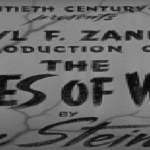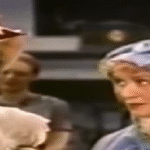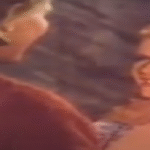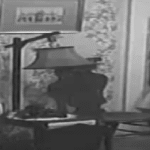Africa Screams is a comedic adventure film released in 1949, directed by Charles Barton and featuring the famous American comedy duo Bud Abbott and Lou Costello. Set against a backdrop of supposed African exploration, the film weaves slapstick humour, mistaken identities, and satirical misadventures into a light-hearted and often absurd storyline. While it purports to follow an expedition into the African wilderness, the film is far more concerned with gags and antics than with geographical accuracy or anthropological authenticity.
The story begins in a New York department store where Stanley Livington, a timid and bookish clerk played by Lou Costello, works in the book section. His partner, Buzz Johnson, portrayed by Bud Abbott, is a fast-talking hustler always looking for a quick buck. The plot is set in motion when a woman named Diana Emerson, played by Hillary Brooke, enters the store inquiring about books on Africa. Buzz, ever the opportunist, overhears her conversation and boasts that Stanley is an expert on the dark continent, even though Stanley’s knowledge of Africa is limited to what he has read in adventure novels and encyclopaedias.
Diana and her partner, the sinister Professor Ross (played by Frank Buck), are secretly seeking a hidden cache of diamonds located somewhere in the African jungle. They believe Stanley holds the key to the map leading to the treasure, mistaking him for a renowned explorer who once journeyed into the region. Buzz seizes the opportunity to get involved, promising Diana that they will assist her with the expedition. Stanley is initially reluctant, having no desire to venture into the wilds of Africa, but he is eventually duped into going along, believing it to be a safe and civilised trip.
The action quickly shifts to Africa, although the landscape presented bears more resemblance to a Hollywood backlot than the actual continent. There, the group sets off on their treasure hunt, joined by a variety of colourful characters, including a hulking strongman named Grappler McCoy (played by Max Baer) and a near-feral jungle native named Bula (portrayed by Shemp Howard of the Three Stooges fame). The journey is beset by countless comedic mishaps: wild animals, treacherous terrain, and internal rivalries provide fertile ground for slapstick chaos.
Stanley, the perpetual coward, is frequently at odds with his surroundings. Whether being chased by a lion, getting stuck in a crocodile-infested river, or mistaking a gorilla for a tribal chief, his bumbling antics serve as the comic heart of the film. Lou Costello’s performance is marked by his typical wide-eyed panic and verbal stammering, contrasting sharply with Bud Abbott’s cool and conniving persona. Buzz spends much of the expedition trying to stay one step ahead of the duplicitous Diana and her associates, while also attempting to keep Stanley from ruining their chances of striking it rich.
As the film progresses, the quest for diamonds becomes more convoluted. The villains’ true motives are gradually revealed, and their willingness to betray their companions becomes evident. Stanley, entirely unaware of the larger conspiracy, stumbles into the film’s climax more by accident than by design. In one of the more memorable sequences, he unwittingly finds the treasure while trying to hide from a charging elephant. Rather than keeping the diamonds, Stanley ultimately decides to do the right thing, attempting to hand them over to what he believes are legitimate authorities.
However, the authorities turn out to be yet another group of imposters, and the diamonds change hands multiple times in a chaotic finale. Eventually, through a combination of luck, pluck, and pratfalls, Stanley and Buzz escape the jungle mostly unscathed, albeit without the riches they sought. The ending sees the two of them back in New York, back to their ordinary lives, reflecting on the absurdity of their African escapade.
From a production standpoint, Africa Screams is notable for including several performers outside the Abbott and Costello sphere. The film includes appearances by real-life animal wrangler Frank Buck, whose inclusion lends a thin veneer of authenticity to the otherwise fantastical jungle setting. Additionally, it features Clyde Beatty, a famous circus lion tamer, in a cameo role. Their presence underscores the film’s appeal as a spectacle as much as a narrative – offering audiences a chance to see exotic animals and thrilling stunts, all filtered through the lens of comedy.
The title Africa Screams is itself a play on words, parodying the 1930 documentary Africa Speaks!, which sought to portray life on the continent from a Western viewpoint. Abbott and Costello’s version is far less concerned with ethnographic detail and far more with cartoonish gags, cultural caricatures, and outrageous set pieces. By modern standards, many of the portrayals in the film are dated and problematic, especially in their depiction of African natives and customs. The characters are broadly drawn, often serving as backdrops to the duo’s antics rather than as fully realised figures.
Yet despite these shortcomings, Africa Screams remains a representative example of post-war American comedy, reflecting both the innocence and the ignorance of its time. It trades in the familiar tropes of the “lost world” genre – hidden treasures, savage wilderness, and Western adventurers – but filters them through a vaudevillian sense of humour. The film’s primary strength lies in the chemistry between Abbott and Costello, whose contrasting styles – the slick straight man and the bumbling fool – provide a reliable formula for laughs.
Critics at the time of release were divided. Some appreciated the sheer silliness of the film, praising its pace and comedic timing, while others found its story shallow and its reliance on slapstick tiresome. Nevertheless, the film has since found a place in the canon of classic comedy, often remembered fondly by fans of the duo. Its public domain status has made it widely available on home video and streaming services, ensuring its survival as a cult favourite.
Africa Screams is less an exploration of Africa than it is a vehicle for Abbott and Costello’s comedy. With its outlandish situations, eccentric characters, and relentless physical humour, the film succeeds in delivering laughs, even if it does so at the expense of cultural sensitivity and narrative coherence. For fans of vintage comedy, it offers a window into a bygone era of entertainment – one filled with charm, chaos, and a healthy dose of screaming.







